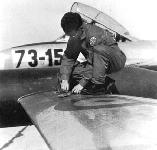Фотографии
-
Initially, the Jet School T-33s retained the 'Arctic Red' zones they sported at the time of arrival. Note that the back bare metal spaces left in both sides of the fuselage after deleting the former USAF insignia were red painted on some aircraft until the scheme was removed.
Самолёты на фотографии: Lockheed T-33A - США - 1948
-
After the EdA reorganization of April 1965, new unit codes (the three leading digits indicating the squadron) were applied. The Jet School E.15s were no exception. Noteworthy are the black square with white numbers (believed to have been painted during the so-called Aeronautical Pentathlon, held at Talavera between April 22-28, 1968) and the paint scheme, applied at the same time as new navigation equipment was installed to the whole EdA T-33 fleet.
Самолёты на фотографии: Lockheed T-33A - США - 1948
-
After two or three tentative unit markings, Jet School T-33s began to wear this scheme in early 1959.
Самолёты на фотографии: Lockheed T-33A - США - 1948
-
E.15-35 in the colours of one of the rarest units in the T-33 Spanish service: 157 Escuadron de Servicios (Services Squadron) under charge of the Moron-based Ala 15, the main squadron of which was the Sabre-equipped 151 Escuadron. This accounts for the orange nose-band and tail badge, a variation of Ala de Caza 5's, carried by this T-33.
Самолёты на фотографии: Lockheed T-33A - США - 1948
-
Most of the T-33A-5-LOs were assigned to the EdA's F-86F fighter units. E.15-35 was delivered to Ala de Caza 1 at Manises - it sports the colours of the unit's 11 Esquadron: red nose-band.
Самолёты на фотографии: Lockheed T-33A - США - 1948
-
No.201 Escuadron was an F-86F-equipped unit based at Torrej on whose main role was ground attack. White nose-band was a common feature of almost every F-86F unit based there, 201 Escuadron's emblem having many of the elements of the other units under charge of the Mando de la Aviation Tactica.
Самолёты на фотографии: Lockheed T-33A - США - 1948
-
Green nose-band and unit code indicate this aircraft was one of two initially delivered to the Son San Juan-based Ala de Caza 4. Neither the F-86Fs nor the T-33s of the unit ever carried its badge.
Самолёты на фотографии: Lockheed T-33A - США - 1948
-
One of four machines assigned to 131 Esquadron, Ala 13, at Valenzuela (Zaragoza). E.15-37 sports the tiger's badge but lacks the compulsory black band distinguishing all the Valenzuela's F-86F unit lineage.
Самолёты на фотографии: Lockheed T-33A - США - 1948
-
Shortly after arriving in Spain, E.15-41 was delivered to the Torrejon-based 98 Escuadron, an F-86F unit assigned to the Cuartel General del Mando Aereo de la Defensa. The unit's emblem was only carried on the starboard side of the front fuselage. Unofficial presentation of tail serial and cross, as well as orange DayGlo tiptanks, indicate that this aircraft was hurriedly delivered to the unit.
Самолёты на фотографии: Lockheed T-33A - США - 1948
-
At the time of the delivery of the new Mirage IIIEE and 'DEs to the Manises-based 101 Escuadron in June 1970, there were still a number of T-33s assigned. When in May 1971 101 Escuadron became 111 Escuadron, most of the 'T-birds' of its predecessor remained with the new unit for some years: hence the blue nose-band carried by E.15-41.
Самолёты на фотографии: Lockheed T-33A - США - 1948
-
'E.15-1' preserved at Talavera is really E.15-60. The nose code is also fictitious.
Самолёты на фотографии: Lockheed T-33A - США - 1948
-
On May 21, 1971 SF-5-equipped 21 Ala was formed, keeping six E.15s, including E.15-53, at Son San Juan in the summer of 1977.
Самолёты на фотографии: Lockheed T-33A - США - 1948
-
Three Jet School E.15s flying in echelon, mid-1958. E.15-4 sports the newly-created Jet School emblem on its tail and the former unit code, which included an unusual 'E'.
Самолёты на фотографии: Lockheed T-33A - США - 1948
-
Lt Santaner removes the filler cap of a T-33's wings tanks. Note what appears to be a coloured band around the nose of E.15-15 '73-15', leading to the suspicion that some Jet School T-33s could have sported such markings - perhaps yellow?
Самолёты на фотографии: Lockheed T-33A - США - 1948
-
After the F-86Fs were phased out of the Jet School, 732 Escuadron received half the E.15s assigned to 731 Escuadron, including ‘E.15-41’.
Самолёты на фотографии: Lockheed T-33A - США - 1948
Статьи
- Round-Out
- The Roundels File
- B.Norton - Ready for the Silent Assault /World war two/ (2)
- D.Nicolle - Fury over Palestine /Post-war conflict/ (2)
- D.Willis - Extended Family /Post-war combat/ (4)
- F.Mormillo - Wings and Rotors /History on the wing/
- G.Bussy - Frustrated Firebrand /Post-war combat/
- G.Cruz, R.Canamares - Iberian 'T-birds' /Air forces/ (2)
- N.Follett - Swift Australians /Between the wars/














